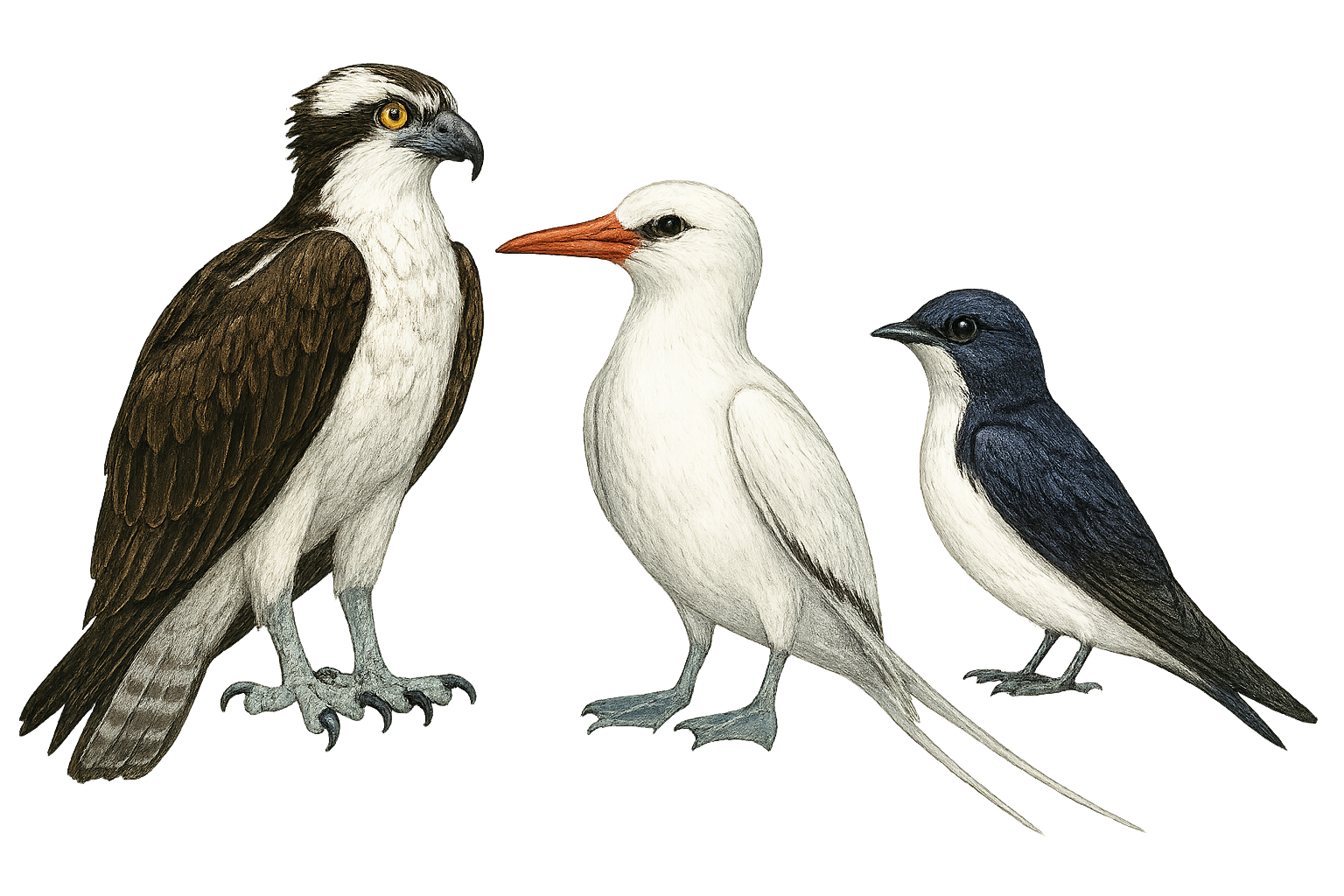The 13 Most Amazing Birds You Can Spot from the Cliff Villa Peninsula
The Cliff Villa Peninsula in Watamula is one of the most dramatic places in Curaçao. Visitors come for the raw limestone cliffs, the constant trade winds, and the endless blue horizon. What many people do not realize is that this peninsula is also one of the best natural bird-viewing platforms on the island. Because of the updrafts rising from the cliffs and the rich feeding grounds offshore, the area often feels like a balcony that looks directly into the lives of Caribbean birds.
Below are 13 incredible species you can see right from the villa, often without binoculars, along with a few surprising facts about each of them.
1. Magnificent Frigatebird (Fregat / Fregata magnificens)
The black pirate of the Caribbean sky.
Males inflate a bright red throat pouch during courtship.
They almost never land on water because their feathers are not waterproof.
Frigates often steal food from other birds in midair with amazing agility.
Look for slow, gliding circles high above the cliffs.
2. Brown Booby (Bubul / Sula leucogaster)
One of Curaçao's most spectacular divers.
They drop from heights of 30 to 40 metres and hit the water like a spear.
A breeding pair tends to raise only one chick at a time.
Juveniles are chocolate brown with blue tinted feet.
Look for dramatic plunges into the waves along the north shore.
3. Crested Caracara (Warawara / Caracara plancus)
A bold raptor that behaves like a mix of falcon and scavenger.
They walk on the ground with surprising confidence.
Caracaras raid iguana nests and steal eggs from other birds.
Locals say the warawara always knows where commotion is happening.
Look for large birds soaring inland with slow wingbeats.
4. Osprey (Pesca Poko / Pandion haliaetus)
A winter visitor that hunts fish along the coast.
Most common from November to March.
Ospreys close their nostrils before they hit the water.
Their talons have barbed pads to grip slippery fish.
Look for a white headed raptor hovering over calmer bays.
5. Red-billed Tropicbird (Pikin Bird di Tropiko / Phaethon aethereus)
A rare treat that sometimes appears far offshore on windy days.
Their white tail streamers are longer than their entire body.
They nest in sea caves and cliff crevices around remote parts of the island.
Their call sounds like a sharp, high pitched scream.
Look for bright white wings with black accents swirling above blue water.
6. Caribbean Martin (Golondrina / Progne dominicensis)
Often swirling above the villa on windy afternoons.
They feed on insects carried upward by the cliffside updrafts.
Males shine with a blue purple glow in bright light.
A single martin can consume hundreds of insects in one hour.
Look for fast sweeping arcs just before sunset.
(With the stress of migration acute exhaustion, dehydration can cause deaths around October in Watamula.)
7. Bananaquit (Barika Hende / Coereba flaveola)
Small, energetic, and full of personality.
They love nectar and defend flowering bushes fiercely.
Known for sneaking sips from sugary drinks left unattended.
Their white eyebrow stripe gives them a bandit like appearance.
Look for constant fluttering around cactus blooms and flowering shrubs.
8. White-tailed Hawk (Ala Blanku / Geranoaetus albicaudatus)
A commanding raptor of Curaçao's dry north coast.
Their white tail has a bold black band that is easy to spot.
They hunt iguanas, snakes, and lizards in the inland scrub.
Wingspan can reach up to one and a half metres.
Look for slow, heavy flight over the inland plateau.
9. Trupial (Icterus icterus)
Curaçao's famous orange and black songbird.
Their flame colored bodies show beautifully against the grey cliffs.
They sometimes mimic calls of other birds.
Trupials build hanging nests in thorny trees for protection.
Look for bright flashes of orange in the divi divi trees around the peninsula.
10. Brown Pelican (Pelikan Marron)
Graceful in the air and surprisingly athletic in the water.
They fly in tight formations just above the waves to save energy.
Their throat pouch can hold up to three litres of water.
Pelicans often hunt cooperatively by driving fish toward one another.
Look for sunset flights along the cliffs, followed by sudden folding dives.
11. Curaçao Emerald Hummingbird (Blòuw Kolibrí / Chlorostilbon mellisugus)
A tiny jewel flashing through the divi-divi trees.
These hummingbirds are exclusive to the ABC islands, with males glowing a deep metallic green.
They beat their wings over 60 times per second, allowing them to fly forward, backward, and even upside down for a split second.
They fiercely guard nectar sources, often chasing birds ten times their size.
Look for: a green metallic blur hovering around flowering aloe, agave, or bougainvillea.
12. Yellow-shouldered Amazon Parrot (Lora / Amazona barbadensis)
Curaçao’s beloved and endangered native parrot.
Found only on a few islands and in parts of Venezuela, making sightings extremely special.
They fly in small, noisy flocks that pass right over the peninsula at dawn and late afternoon.
Their yellow shoulder patch and bright green body make them easy to identify.
Look for: pairs flying low over the inland hills, calling with sharp, rolling notes.
13. Caribbean Barn Owl (Olu / Tyto alba insularis)
The ghost bird of Curaçao’s nights.
Rare night sighting, these owls nest in sea caves, abandoned buildings, and rocky crevices around Westpunt.
They fly silently thanks to special serrated wing feathers that cancel sound.
Locals see the owl as a good omen because it keeps rodent populations low.
Look for: pale, heart-shaped faces gliding silently through moonlit air after sunset.
Why the Cliff Villa Peninsula Is a Bird Watcher's Dream
From the peninsula you can see:
Open ocean, which attracts seabirds
Strong wind currents that lift frigates and hawks to eye level
Rocky coves where diving birds feed
Dry tropical forest habitat just inland for songbirds and raptors
It is one of the few places on the island where pelicans, frigates, boobies, warawara, martins, and trupials can all be seen in the same hour.





